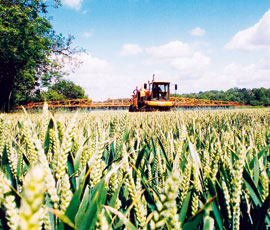New SDHI chemistry may have key role at T2

Plans for T2 sprays should take account of higher grain prices and yellow rust concerns, but there is still some debate as to the value of using new SDHI chemistry if conditions remain dry.
With wheat prices at near record levels, additional margins can be gained by using the new fungicides to go for higher yields, says Syngenta business analyst Mark Hall.
“Growers have the opportunity to farm for profit this year,” he says. “The earlier sprays have gone on in almost perfect conditions, so there’s a chance to push crops harder and achieve maximum yields.”
The extra £5-8/ha cost of the company’s new Seguris fungicide (epoxiconazole + isopyrazam) over current standards isn’t an issue, he says. “There’s a return from using this chemistry at T2 whether disease pressure is high or low.”
But low responses to fungicides in 2010 are prompting some growers and advisers to question whether this season’s dry spring could have a similar effect by harvest 2011, he acknowledges.
“There are differences between this year and last. Yellow rust is one of them. It doesn’t need moisture to regenerate and it’s reappearing in treated crops already.”
Paul Drinkwater, crop production manager at Abbots Ripton Farming Company, near Huntingdon, has already decided to try out Seguris on rust susceptible varieties Oakley and Solstice. “It’s in the shed and I’m going to take a look at it,” he says.
He has seen trials with the product over the past two years and is expecting to get longer-lasting disease control. But he also notes that the biggest responses from SDHIs were seen in 2008, with no benefit recorded from their use last year.
“The fact that Seguris is stronger on yellow rust is in its favour,” he says. “And it may well be that its ability to reduce drought stress could be useful this season.”
His normal strategy at T2 is an epoxiconazole/Amistar Opti mix (azoxystrobin + chlorothalonil), which he admits is a bit cheaper. “I’m given a fungicide budget and expected to stick to it. So far, this year has been very straightforward and we’re on track.”
Jock Willmott of Strutt and Parker’s farming department in East Anglia is still undecided about T2 choices. While he stresses that 2011 is not the year to let crops succumb to disease, he believes that dose is more important than the fungicide used.
“Good rates are essential,” he advises. “There are opportunities to buy fungicides well, so it isn’t always necessary to pay more to get good results.”
His spend on T2 will be the same as last year’s, which was £28-30/ha. “Remember that epoxiconazole is £5/litre less than it was in 2010. So look at what you can get for your money.”
Mr Willmott welcomes the new chemistry and predicts it will be used extensively. However, his concern is that it didn’t show a response in 2010, in a dry year, so he needs more information to understand where it will give the most benefit.
“At the moment, it’s between using 0.75-0.8 dose of triazole plus a strobilurin at T2, or switching to one of the new SDHIs. But my main concern is to keep crops clean.”
Drought Effects
The role of SDHIs in alleviating drought stress shouldn’t be ignored, warns Bill Clark of Broom’s Barn.
“As much as 30% of UK wheat is grown on drought-prone land,” he says. “Last year, wheat being grown on light land lost 38% of its potential yield.”
The physiological effects of SDHIs are still being investigated, but their ability to maintain green leaf area and reduce drought stress make a contribution to the 0.3-0.4t/ha yield benefit that can be expected from their use, he adds.
“It appears that drought stress reduction comes from both T1 and T2 applications. The first spray has an effect on rooting, while the second seems to affect stomatal conductance.”
In hot, dry weather, the stomata close to prevent the leaf losing water and the leaf rolls up, he explains. “The crop can’t exchange carbon dioxide like this, so grain filling stops.”
If the stomata stay open, grain filling continues. “And that’s important because the crop gains 0.2t/ha/day during this stage.”
All the physiological benefits from SDHIs are dose related, says Mr Clark. “The biggest risk that most cereal growers face this season is not putting enough on. You have to build the yield response.”

